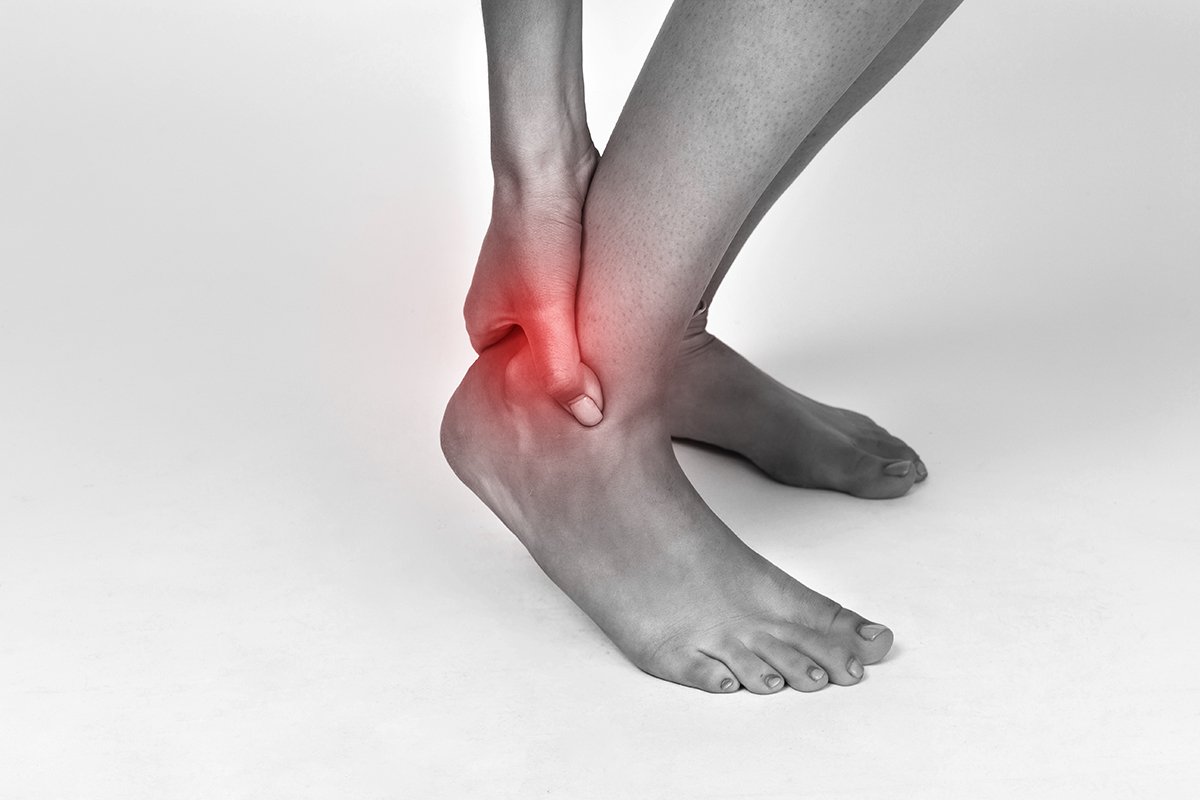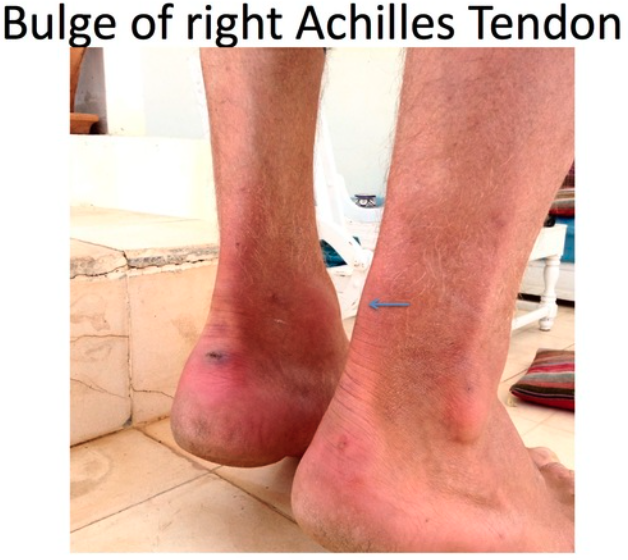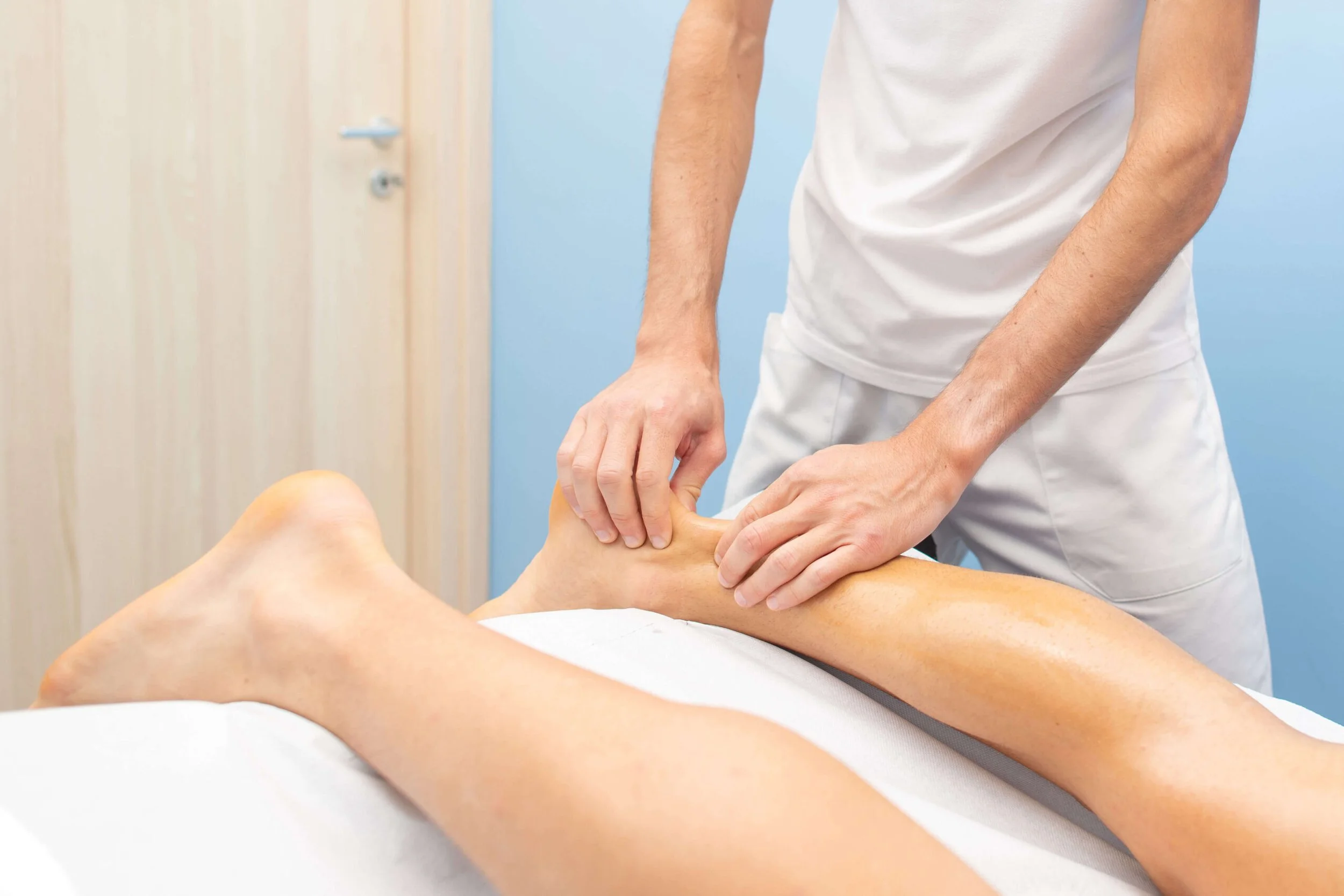Achilles Tendinopathy
In this blog I talk about Achilles tendinopathy, a common injury usually due to overuse of the tendon without adequate time to recover in between exercise. I look at ways to begin your own self-healing exercises if you have to wait for an appointment with your doctor or physio.
Tendon pain can start after the tendon has already been overused for some time without rest so when you feel a twinge or constant pain seek help straight away and stop what ever you are doing.
Symptoms
Pain
There are three main types of tendon injury (tendinopathy) and three types of Pain:
1.Pain in the mid section of tendon (Mid section tendinopathy)
2. More rarely pain at the heel, where the tendon attaches to the heel bone. (insertional tendinopathy)
3. Pain along the whole length of the outer tendon.( Peritendon swelling/inflammation)
Swelling
1.You may have noticed swelling along a short section of the tendon, or prominent bulge. Or the tendon may already have become thickened and wider.
2. There may be a bony lump at the heel bone where the tendon attaches.
3. If the all the tissue around the tendon is swollen, then you may even hear a ‘crackling’ when you massage the area- Massage is NOT advised in this condition.
Stiffness
Morning stiffness can be debilitating and it often takes half an hour to loosen up and stretch out the tendon.
If you stop the overuse activity it should settle, but if you don’t treat the tendon with an exercise programme below, stiffness will return when you re-start your activity.
Mid Section Achilles Tendon Pain
I'm going to discuss treatment for mid-section Achilles tendon pain. This is the most common site for tendon pain. Eccentric strengthening exercises and stretching of the calf muscles work to heal the injured tendon fibres; however, be aware that the strengthening exercises can cause pain during the first 2-3 weeks and a lot of patients just stop doing them and give up.
If your pain is mostly at the heel where the Achilles attaches, then heel-drops may make this worse.
Getting Started Yourself With Exercises
If you have to wait to see your doctor or physiotherapist then try the following:
Stop the repetitive exercise that has caused your injury
Start wearing a heel-raise insole greater than 18mm depth. This reduces the tension in the tendon, allowing it to relax. Talk to your physiotherapist about how long you should use it for.
If you have a fallen arch (flat-feet) it will help to wear an arch support, which a podiatrist can make for you. Sometimes these can be expensive, so you might want to begin with buying one yourself.
You can try an anti-inflammatory such as ibuprofen, if you don’t have stomach problems or kidney disease. Just remember that if you’ve had the pain for a few months, there is usually no inflammation in the tendon, so you are really only treating the pain and stiffness.
Start working on your core muscle strength. I recommend Pilates classes, or you can begin with bridging and leg raises which I have demonstrated in a ten minute video on the exercise for adults page.
When to consult Your Doctor
There are three reasons for seeing your Doctor.
1. You may have a normal Achilles tendon. Pain maybe referred pain from the lower back, to the ankle, or you may having swelling from another muscle in the lower leg, or you could have swelling in the bursae (this a small pad life structure that the tendon glides over at the heel).
2. Your doctor can organise an ultra sound scan of the Achilles tendon and refer you to see a physiotherapist if this is uncomplicated tendonitis.
3. In a very small number of cases, Achilles pain is a sign that there is underlying ' inflammation' elsewhere in the body, which has shown-up as a tendonitis. This inflammation often affects the spine, joints, bowel, and skin. But sometimes, you may have no other symptoms only Achilles pain.
In this case you should have an Ultra-sound scan to visualise if the tenon in affected where it attaches to the heel bone, an X-ray of the Sacrum and some bloods if an inflammatory arthritis is suspected. Your doctor will also refer you to a Rheumatologist.
When to consult a physiotherapist
You should see a physio/physical therapist as soon as possible. They will assess the tendon, verify the exact cause of your pain, and recommend an appropriate exercise plan. They will also look for predisposing factors to tendon pain such as poor muscle strength in the core or calf muscles, lack of flexibility in the ankle joint, or a flat/high arched feet. If you play a sport, the physio may want to observe exactly how you ‘move’ when you are doing a sporting activity.
Also the physio will assess the tendon in case it is painful at the insertion into the heel in which case stretching may make it worse.
Treatment
The exercise programme can last from 6 weeks to 12 months. You should start by doing the exercises every day, twice a day for 6 weeks. It is useful to write down all the exercises you do each day and how you feel, then you can see your progress. If you miss a few days or the weekends, that's normal, just keep going.
The 'Alfredson Eccentric strengthening programme’ or ‘heel-drop programme', has been shown to change the collagen cells in the tendon, back towards a more normal shape. These exercises were found to work as early as the 1980's, but it wasn't until Alfredson and his team did further studies in the 1990's that they became the focus of most treatment.
Your physiotherapist will show you how to do the exercises and how to increase the weight you lift every 1-2 weeks, using a backpack (See below for example programme). Remember this is a 'heel-drop' exercise. You have to use your good leg to return to the starting position- this is very important. See the video below.
Exercise Programme For Mid Section Achilles Tendon Pain Think ‘Heel Drop’
What is Eccentric?Most tendon pain improves with strength training of the muscle-tendon unit in the lower leg. Both concentric and eccentric exercises can help reconstruct new tendon but these exercises must e done within a 'Medium' pain threshold i.e. you will experience some pain but it should not be more the 5 out of 10. Although not all physiotherapists agree with purely eccentric exercise programme to begin it is still an important exercise to teach the patient to do and understand. Eccentric means the muscle lengthens as you put weight through it. It is the opposite to concentric where the muscle shortens.
The Achilles tendon forms when two muscles come together- the gastrocnemius and Soleus muscles. Because the gastrocnemius crosses the knee joint you need to have the knee straight in order to stretch and strengthen it. Whereas the Soleus muscle runs from the heel to the top of the calf and does not extent further up to cross the back of the knee.
Use the good leg, in this case the left leg, to resume the starting position of standing on your toes.
Then put all the weight through your right leg, if possible, and lower into heel drop.
From heel drop return to standing on your toes by using your left leg to push up.
HEEL DROPS
Example patient weights 50kg
Start with no added weight. Perform 15 heel drops X 2 with leg straight, 15 heel drops x2 with knee slightly bent TWICE A DAY FOR 1-2 WEEKS
Once the exercise becomes almost pain free, your physio will add in a weight, starting with approximately 10% of your body weight i.e. 5kg
5kg [15x2 leg straight, 15x2 knee bent] TWICE A DAY for 1-2 weeks or until it becomes pain free.
7.5kg [15x2 leg straight, 15x2 knee bent] TWICE A DAY for 1-2 weeks or until it becomes pain free.
10 kg [15x2 leg straight, 15x2 knee bent] TWICE A DAY for 1-2 weeks or until it becomes pain free.
12.5kg [15x3 leg straight, 15x2 knee bent] TWICE A DAY for 1-2 weeks or until it becomes pain free.
15 kg[15x3 leg straight, 15x2 knee bent] TWICE A DAY for 1-2 weeks or until it becomes pain free.
“You may find you need to use a lighter weight at the beginning (e.g. 2.5kg) or that you need more than two weeks lifting no weights. Each person’s injury is different, so their treatment will be different.”
— DR. SIOBHAN GRAHAM
Additional Treatments
Short-term use of an anti-inflammatory medication, such as ibuprofen, can help pain and stiffness, but make sure you consult your doctor or pharmacist first. They can cause stomach ulceration, increase blood pressure and affect your kidneys. It worth remembering that once the tendonitis has been there for many months, there is usually no longer any inflammation, so if you need a pain-killer paracetamol may be enough to manage your pain.
Your doctor may also try a small patch, called 'Glyceryl Trinitrate', which is applied to the skin over the tendon. This will increase the blood supply to the area. Results are variable, but if you do not experience side-effects from the patch it is worth a try for 1- 2 weeks. It is used for angina, but is not licensed in the UK for this use in Achilles tendinopathy, so speak to your Doctor.
Massage can give great pain relief and stimulate blood supply. If there is paratendon inflammation it can make this worse, so massage is usually avoided.
Electrotherapy shock-wave therapy is useful for non calcified tendinoapthy
Steroid Injection should always be the last treatment to consider. It has good pain relieving affects, but may not change the tendon. It needs be carried out using an ultra- sound scan to guide the needle into the correct position. There is a very small risk of the tendon rupturing, so talk to your Doctor.
Core strengthening: Your Doctor or physio will recommend some exercises to improve the strength of your abdominal, pelvic and lower back muscles. this is where power is generated when using the extremities such as the legs and arms. You can also follow my exercise video for hip/knee pain.
Biomechanical assessment: the feet can hold the answer to why you developed tendonitis. Also how you walk or run may contribute. A sports podiatrist or biomechanical podiatrist can carry out a full assessment and recommend treatment such as an insole.
Surgery: In some cases surgery is required. Satisfaction rates after surgery, from patients with insertional tendinopathy, are high.
Balance work: After 4-6 weeks of the heel-drop programme try a simple balance exercise such as standing on one leg, keeping the hips horizontal and hold for 10-20 seconds. If this is too easy, try standing on a cushion.
Bare foot running: some patients have had benefit with running in a bare-foot style shoe, although evidence to support this for everyone is still unclear
Anti-oxidants such as green tea can also help with symptoms. I recommend one cup twice a day for 6-12 months and encourage adopting this as your beverage of choice.
Curcumin, also known as the yellow spice turmeric, is used by many herbalist Doctors, with good affect. It is fat soluble which means you absorb more if taken with fat in the diet, such as full fat Greek yogurt or Olive oil.
You can read more information on tendonitis on the NHS choice website.
References
ALFREDSON, H. & COOK, J. 2007. A treatment algorithm for managing Achilles tendinopathy: new treatment options. Br J Sports Med, 41, 211-6.
COOK, J. L., KHAN, K. M. & PURDAM, C. 2002. Achilles tendinopathy. Manual Therapy, 7, 121-130.
DE-SIMONE, C., GUERRIERO, C., GIAMPIETRUZZI, R. & COSTANTINI, M. 2003. Achilles tendinitis in psoriasis: Clinical and sonographic findings. Journal American Academy Dermatology, 49.
KEDIA, M., WILLIAMS, M. & JAIN, L. 2014.THE EFFECTS OF CONVENTIONAL PHYSICAL THERAPY AND ECCENTRIC STRENGTHENING FOR INSERTIONAL ACHILLES TENDINOPATHY. The International Journal of Sports Physical Therapy, 9, 488-497.
PETERS, J. A., ZWERVER, J., DIERCKS, R. L., ELFERINK-GEMSER, M. T. & VAN DEN AKKER-SCHEEK, I. 2016. Preventive interventions for tendinopathy: A systematic review. J Sci Med Sport, 19, 205-11.
UQUILLAS, C. A., GUSS, M. S., RYAN, D. J., JAZRAWI, L. M. & STRAUSS, E. J. 2015. Everything Achilles: Knowledge Update and Current Concepts in Management: AAOS Exhibit Selection. J Bone Joint Surg Am, 97, 1187-95.
WIEGERINCK, J. I., KERKHOFFS, G. M., VAN STERKENBURG, M. N., SIEREVELT, I. N. & VAN DIJK, C. N. 2013. Treatment for insertional Achilles






